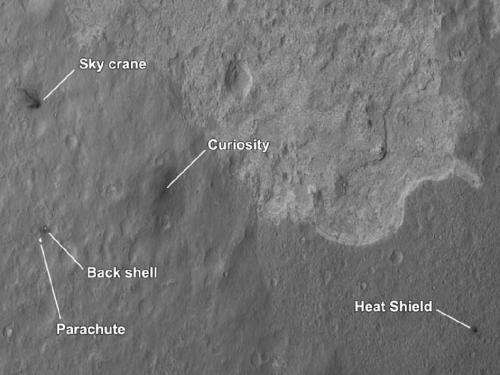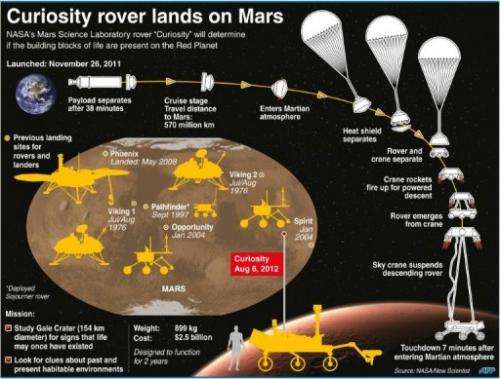NASA shows first 'crime scene' photo of Mars landing

About 36 hours after NASA landed its $2.5 billion rover on Mars, it released Tuesday what it jokingly dubbed a "crime scene" aerial shot of where the parachute, heat shield and vehicle came down.
The touchdown on August 6 of the Mars Science Laboratory involved the most elaborate attempt yet to drop a robotic car on the surface of the Red Planet, and required a heat shield, supersonic parachute and rocket-powered sky crane.
The process, known as entry, descent and landing, or EDL, was referred to as "Seven Minutes of Terror" by NASA, but went off without a hitch, in what US President Barack Obama called an "unprecedented feat of technology."
On approach, a heat shield protected the Curiosity rover's fiery entry into Mars' atmosphere, a supersonic parachute deployed to slow it down, and the spacecraft back shell separated.
Then, a rocket powered backpack was fired to power the one-ton rover downward before it was lowered by nylon tethers. The sky crane was designed to detach and fly away to crash somewhere to the north.
The latest black and white picture released Tuesday was taken by the Mars Reconnaissance Orbiter as it flew about 300 kilometers (185 miles) above the landing site of Gale Crater, near Mars' equator.
It shows the Mars Science Laboratory rover, nicknamed Curiosity, with the now defunct sky crane about 650 meters (yards) away to the northwest.
The parachute and backshell of the spacecraft that separated before it lowered down landed about 615 meters away from the rover to the southwest.

The heat shield appears to be about 1,200 meters from the rover to the southeast.
"This is like a crime scene photo here," said Sarah Milkovich, a NASA scientist who is the lead investigator of the HiRISE camera on the Mars orbiter.
"Hopefully in our future images we be able to get even better, more detail," she said, adding that the dark areas in the photo show where dust was kicked up during the landing.
The EDL team has reviewed the latest photos and said "the layout looks kind of the way they expected," according to mission manager Mike Watkins.
The pieces will likely stay on Mars. There are no plans to recover them to bring back to Earth.
NASA is continuing to run tests on the various instruments on board the rover, which aim to help hunt for signs that life may once have existed on Earth's neighbor planet, once believed to be a wetter place than it is today.
So far most of the checks have gone well and the rover appears to be in good shape.
On Wednesday, NASA plans to lift the rover's remote sensing mast for the first time. More images, including color high-resolution shots, are expected to arrive in the coming days.
But the rover is not expected to start moving for several more weeks, and it may be a year before it reaches its scientific target of Mount Sharp.
Deputy project scientist Joy Crisp said the latest analysis shows that the rover is 6.5 kilometers from the base of the mountain, if it were to travel straight there.
However, scientists have warned it is difficult to estimate the exact start of the base and they have no plans to drive to it directly, but will likely take a more meandering route.
The Mars Science Laboratory is a nuclear-powered vehicle that is designed for a two-year robotic mission on Mars, though scientists hope it will last as least twice its original design life.
(c) 2012 AFP



















